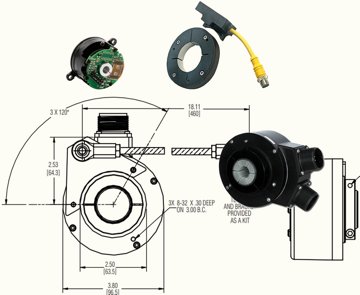Although stainless steel is the most common choice for corrosive environments, you can also use anodized aluminum encoders. An anodized aluminum encoder is much lighter in weight than stainless steel, and offers benefits such as sulfur inertness, corrosion resistance and chemical inertness. However, it is common to paint the aluminum housing to help protect it from corrosive elements, such as salt.
Can I Use an Anodized Aluminum Encoder in Corrosive Environments?
Posted by London Rhodes on Mar 22, 2021 11:35:33 AM
Topics: How to Choose An Encoder
When Should I Use a Stainless Steel Encoder?
Posted by London Rhodes on Mar 19, 2021 3:09:07 PM
Stainless steel encoders are preferred in applications that are subject to corrosive elements. For example, salt baths and wash downs are common in the Food and Beverage industry. In this case, a stainless steel encoder is most appropriate due to its ability to withstand salt water exposure over time.
Topics: How to Choose An Encoder
What is the Difference in Single and Dual Output Encoders?
Posted by London Rhodes on Mar 19, 2021 2:13:33 PM
The difference in single and dual output encoders is simple. A Single output encoders has one connector while a dual output encoder has two. Having a dual output encoder is like having two encoders contained in one housing. However, both outputs are electrically isolated from one another.
How do Unidirectional and Bidirectional Encoders Differ?
Posted by London Rhodes on Mar 19, 2021 2:06:42 PM
A unidirectional encoder, also known as a single channel encoder, is primarily used for speed sensing applications. A single channel encoder only generates one signal as an output (signal A).
What is an Encoder Index Pulse?
Posted by London Rhodes on Mar 19, 2021 1:41:44 PM
The index pulse signals when the encoder shaft completes a single revolution. An index pulse is used for precision homing and count verification is various applications. It is better to have an index pulse on your encoder and not need it, rather then need it and not have that option.
Topics: Encoder Signals Output
Can an Additional Sensor Module be Added to an Existing RIM Tach® NexGen Series?
Posted by London Rhodes on Mar 19, 2021 9:49:23 AM
If you have a standard, single output RIM Tach® NexGen encoder, it is possible to add another sensor to create a dual output unit. Each RIM Tach® NexGen encoder housing is designed with openings for two sensor modules, however, an additional module can be added to get a dual output. As long as it is within the same base PPR family, a different PPR can be added.
How Far Away Can My Encoder be From the Drive?
Posted by London Rhodes on Feb 16, 2021 7:22:44 PM
There is no simple answer to the length of a drive distance for encoders. Dynapar offers many feature options for encoders. If one simply uses high grade Teflon coated cable instead of PVC, the capacitance decreases from 37pF/Ft to ~12pF/Ft, tripling the useful drive distance. This variation in drive distance is solely based on the type of connection wire implemented
Topics: Installation
Should I Connect My Case Ground?
Posted by London Rhodes on Feb 16, 2021 7:21:35 PM
Case ground conductor are the preferred grounding method for encoders. The function of the case ground differs from the cable shield, which also makes contact with the encoder connector.
Topics: Installation
How Quickly Can Your Absolute Encoder Report its Position?
Posted by London Rhodes on Feb 16, 2021 7:16:00 PM
Absolute encoders operate on a question-answer system, completely different from incremental encoders. During the operation of an absolute encoder, an outside controller locates the encoder position. The encoder sends the controller its ID codes, data bits, and end bits. Each step in the process takes time and varies from model to model and manufacturer to manufacturer. The differing data protocols allow users to set various bit rates (Baud), types of error codes, and data styles.
Topics: Absolute Encoders
